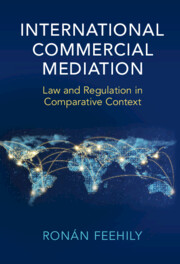Refine search
Actions for selected content:
28 results
14 - Regulating LawTech for Digital Systems
- from Part IV - Evolution of LawTech
-
-
- Book:
- The Cambridge Handbook of the Governance of Technology
- Print publication:
- 13 November 2025, pp 241-262
-
- Chapter
- Export citation
6 - Power and Persuasion
- from Part II - Settlement Practices and Perspectives of Judges
-
- Book:
- Vanishing Legal Justice
- Published online:
- 20 March 2025
- Print publication:
- 03 April 2025, pp 115-132
-
- Chapter
- Export citation
5 - Untold Narratives
- from Part II - Settlement Practices and Perspectives of Judges
-
- Book:
- Vanishing Legal Justice
- Published online:
- 20 March 2025
- Print publication:
- 03 April 2025, pp 99-114
-
- Chapter
- Export citation
1 - Judicial Role in Transition
- from Part I - Vanishing Trials, Transformed Legal Systems
-
- Book:
- Vanishing Legal Justice
- Published online:
- 20 March 2025
- Print publication:
- 03 April 2025, pp 7-15
-
- Chapter
- Export citation
3 - New Legal Families
- from Part I - Vanishing Trials, Transformed Legal Systems
-
- Book:
- Vanishing Legal Justice
- Published online:
- 20 March 2025
- Print publication:
- 03 April 2025, pp 60-86
-
- Chapter
- Export citation
7 - A New Paradigm for Judicial Involvement
- from Part III - Legal Metamorphosis?
-
- Book:
- Vanishing Legal Justice
- Published online:
- 20 March 2025
- Print publication:
- 03 April 2025, pp 135-163
-
- Chapter
- Export citation

Vanishing Legal Justice
- The Changing Role of Judges in an Era of Settlements and Plea Bargains
-
- Published online:
- 20 March 2025
- Print publication:
- 03 April 2025
3 - Drug allergy versus adverse reactions
-
- Book:
- Handbook of Dental Therapeutics
- Published online:
- 23 February 2024
- Print publication:
- 14 March 2024, pp 44-56
-
- Chapter
- Export citation
15 - Oral adverse drug reactions
-
- Book:
- Handbook of Dental Therapeutics
- Published online:
- 23 February 2024
- Print publication:
- 14 March 2024, pp 293-327
-
- Chapter
- Export citation
The Age of Consumer Law Enforcement in the European Union: High Hopes or Wishful Thinking?
-
- Journal:
- European Journal of Risk Regulation / Volume 15 / Issue 3 / September 2024
- Published online by Cambridge University Press:
- 09 October 2023, pp. 625-636
-
- Article
-
- You have access
- Open access
- HTML
- Export citation
63 - Economic Analysis of Arbitration
- from Part XIII - Arbitration and Related Fields
-
-
- Book:
- Cambridge Compendium of International Commercial and Investment Arbitration
- Published online:
- 18 February 2023
- Print publication:
- 02 March 2023, pp 1910-1935
-
- Chapter
- Export citation
11 - Online Dispute Resolution and the End of Adversarial Justice?
- from Part III - Legal Tech and Access to Justice
-
-
- Book:
- Legal Tech and the Future of Civil Justice
- Published online:
- 02 February 2023
- Print publication:
- 09 February 2023, pp 251-285
-
- Chapter
-
- You have access
- Open access
- HTML
- Export citation

International Commercial Mediation
- Law and Regulation in Comparative Context
-
- Published online:
- 01 September 2022
- Print publication:
- 08 September 2022
11 - Litigation-Related Clauses: Enforcement, Settlement and Dispute Resolution
- from Part II - License Building Blocks
-
- Book:
- Intellectual Property Licensing and Transactions
- Published online:
- 21 June 2022
- Print publication:
- 30 June 2022, pp 313-361
-
- Chapter
-
- You have access
- Open access
- HTML
- Export citation
16 - Multi-tier Dispute Resolution in Russia
- from Part III - Multi-tier Dispute Resolution in the Wider World
-
-
- Book:
- Multi-Tier Approaches to the Resolution of International Disputes
- Published online:
- 09 December 2021
- Print publication:
- 16 December 2021, pp 384-396
-
- Chapter
- Export citation
11 - Multi-tier Commercial Dispute Resolution Processes in the United States
- from Part III - Multi-tier Dispute Resolution in the Wider World
-
-
- Book:
- Multi-Tier Approaches to the Resolution of International Disputes
- Published online:
- 09 December 2021
- Print publication:
- 16 December 2021, pp 271-293
-
- Chapter
- Export citation
6 - Perspectives and Challenges of Multi-tier Dispute Resolution in Japan
- from A - General Trends
-
-
- Book:
- Multi-Tier Approaches to the Resolution of International Disputes
- Published online:
- 09 December 2021
- Print publication:
- 16 December 2021, pp 142-160
-
- Chapter
- Export citation
1 - Mapping and Assessing the Rise of Multi-tiered Approaches to the Resolution of International Disputes across the Globe
- from Part I - A Global Overview of Multi-tier Dispute Resolution: Main Themes
-
-
- Book:
- Multi-Tier Approaches to the Resolution of International Disputes
- Published online:
- 09 December 2021
- Print publication:
- 16 December 2021, pp 3-24
-
- Chapter
- Export citation
8 - Combinations of Mediation and Arbitration
- from A - General Trends
-
-
- Book:
- Multi-Tier Approaches to the Resolution of International Disputes
- Published online:
- 09 December 2021
- Print publication:
- 16 December 2021, pp 182-202
-
- Chapter
- Export citation
8 - Digital Dispute Resolution
- from Part II - Legal Tech and ADR
-
-
- Book:
- The Cambridge Handbook of Lawyering in the Digital Age
- Published online:
- 18 November 2021
- Print publication:
- 25 November 2021, pp 140-156
-
- Chapter
- Export citation
